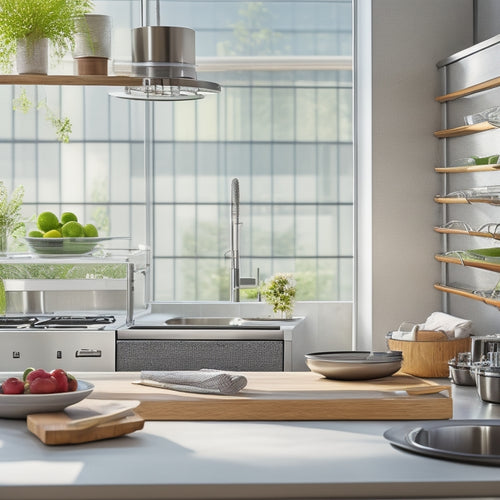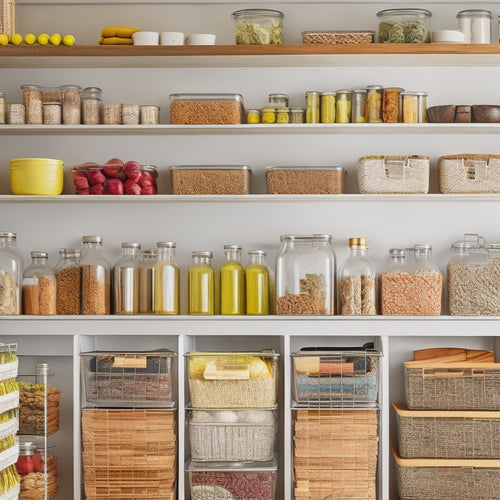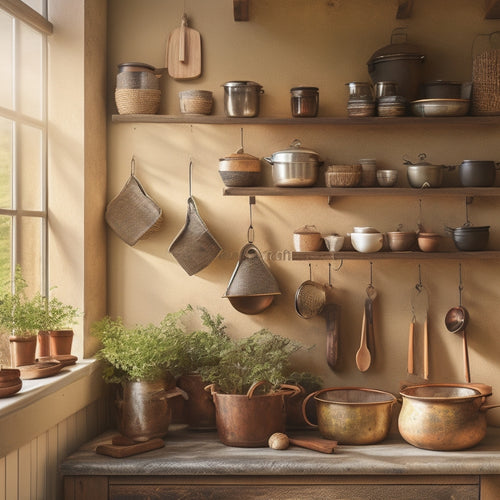
Embark on Your Fermentation Journey
Share
To begin your fermentation journey, start by setting up a clean and accessible space with airtight vessels and a controlled environment. Use high-quality ingredients, such as natural sea salt and purified water, to support beneficial microorganisms and prevent unwanted contaminants. Start with simple recipes, like fast pickles or dairy ferments, to explore fermentation and build confidence. Supplement your learning with online courses, books, and workshops, and connect with fellow fermentation enthusiasts for guidance and problem-solving. By establishing a solid foundation, you'll be well on your way to revealing the full potential of fermentation and discovering the intricacies of this ancient preservation method.
Key Takeaways
• Allocate a dedicated space for fermentation, ensuring cleanliness, stability, and accessibility to control the fermentation process.
• Use high-quality, unrefined sea salt and filtered water to create an ideal environment for beneficial microorganisms to thrive.
• Select seasonal, organic, and local vegetables to ferment, which will support the growth of beneficial microorganisms and inhibit unwanted contaminants.
• Explore simple, wild fermented recipes without a starter culture to gain hands-on experience and build confidence in fermentation techniques.
• Leverage online resources, such as courses, books, and forums, to learn from experienced fermenters, troubleshoot issues, and refine skills.
Setting Up Your Fermentation Space
When establishing a fermentation space, it is important to allocate a clean, stable, and accessible area that can accommodate the necessary equipment and provide a controlled environment for the fermentation process.
Fermentation vessel choices are significant, and glass or ceramic containers of various sizes are suitable options. It is necessary to ensure that the vessel is airtight and can be properly sealed to prevent contamination.
Weighting down ferments is also critical to keep them submerged under the brine, preventing mold growth. A heavy, waterproof object or a fermentation weight can be used for this purpose.
Essential Ingredients for Success
With a suitable fermentation area set up, attention can now be focused on selecting the right ingredients to support the growth of beneficial microorganisms and inhibit unwanted contaminants. This involves choosing the right salt, water, and vegetables for your fermentation process.
| Ingredient | Description |
|---|---|
| Salt | Choose a high-quality, unrefined sea salt to inhibit unwanted microbial growth. |
| Water | Utilize filtered water to eliminate residual disinfectants that can harm beneficial microorganisms. |
| Vegetables | Select seasonal, organic, and local vegetables to guarantee excellent fermentation outcomes. |
Recipes to Get You Started
Simple wild fermented recipes that don't require a starter culture are an excellent way to initiate your fermentation journey. These recipes allow you to explore the world of fermentation without the need for specialized equipment or ingredients.
Quick pickles, for instance, can be made with just vegetables, salt, and water, and are a great way to introduce yourself to the process. Dairy ferments, such as yogurt or kefir, are also easy to make and require minimal equipment.
These recipes are not only delicious but also provide a safe and controlled environment to learn about fermentation. By starting with these simple recipes, you can build confidence and develop the skills needed to move on to more complex ferments.
Learning Resources for Fermenters
Equipped with the right recipes and basic understanding of fermentation principles, fermenters can further enhance their skills and knowledge by exploring various learning resources.
To explore deeper into the world of fermentation, consider the following resources:
-
Online courses, such as Fermenters Club Academy, offering in-depth learning on making fermented foods
-
Recommended books for beginners, including 'Wild Fermentation' and 'The Art of Fermentation' by Sandor Katz, and 'The Everyday Fermentation Handbook' by Branden Byers
-
Online forums and communities, where fermenters can share experiences and learn from others
- Workshops and classes, providing hands-on experience and guidance from experienced instructors
Tips From Fellow Fermentation Enthusiasts
Beyond the wealth of information available through learning resources, valuable insights can also be gleaned from the experiences of fellow fermentation enthusiasts.
When it comes to fermentation troubleshooting, community support can be a lifeline. Online forums and social media groups dedicated to fermentation provide a platform for enthusiasts to share their experiences, ask questions, and offer guidance.
Fellow fermenters can offer valuable advice on flavor experimentation, ingredient swaps, and overcoming common challenges. By tapping into this collective knowledge, beginners can avoid common pitfalls and refine their techniques.
Additionally, online communities often share recipes, tips, and tricks, allowing individuals to expand their fermentation repertoire and explore new flavors and ingredients.
Frequently Asked Questions
What Are the Benefits of Using a Heavy, Waterproof Object to Weigh Down the Ferment?
Like an anchor stabilizing a ship, a heavy, waterproof object weighs down the ferment, ensuring submerged vegetables and preventing mold growth. Fermentation weights offer a convenient alternative, providing proper weighing techniques and equipment options for a safe and successful fermentation process.
Can I Use a Metal Container for Fermentation Instead of Glass or Ceramic?
When considering a metal container for fermentation, be cautious as it can react with acidic or salty environments, potentially contaminating the fermentation process and affecting the quality of the final product.
How Often Should I Check on My Ferment During the Fermentation Process?
During fermentation, regular monitoring is vital to guarantee best conditions. Check ferments every 24-48 hours to maintain pH, temperature, and microbial balance. Frequent checks prevent contamination, spoilage, and off-flavors, ultimately yielding a safe and successful fermentation outcome.
Is It Necessary to Use a Fermentation Airlock Lid or Can I Cover It With Cloth?
When using fermentation vessels, consider material options carefully. Cloth covering can be used, but may allow contaminants in. Airlock lids, like Masontops, provide a secure, oxygen-free environment, ensuring a safe and successful fermentation process.
Can I Ferment Fruits and Dairy Products Together in the Same Container?
'As we explore the domain of fermentation, an important consideration arises: can fruits and dairy products coexist in harmony within the same vessel? The answer lies in understanding fruit combinations and dairy precautions to guarantee a safe and successful fermentation process.'
Related Posts
-

Top-Rated Dish Drainers for Kitchen Use
Top-rated dish drainers enhance your kitchen's efficiency and aesthetics. You'll find compact designs that save preci...
-

Tiered Racks for Kitchen Pantry Organization
Tiered racks can enhance your kitchen pantry by maximizing vertical storage and increasing visibility. They help you ...
-

Wall-Mounted Racks for Kitchen Tool Storage
Wall-mounted racks are perfect for maximizing storage in your kitchen. By utilizing vertical space, you can free up u...


